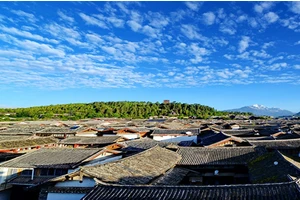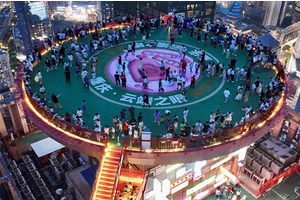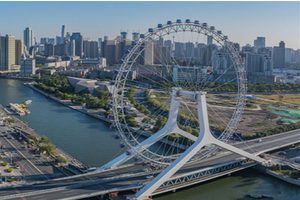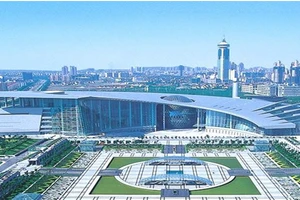Shiling travel
Shiling Street is located in the central and eastern part of Chengdu Plain, and its jurisdiction is located in the shallow hilly area where Longquan Mountain range transits to the western Sichuan Plain, which is a shallow hilly area between flat dams. The overall terrain is high in the southwest and low in the northeast, with the highest elevation of 535 meters and the lowest elevation of 494 meters. With the acceleration of the urbanization process of Shiling Street, the shallow hills gradually disappear (except Qinglong Lake Park), and what they get is mainly the urban landscape.
Shiling Street is bordered by Baohe Sub-district Office in chenghua district in the west, Longtan Sub-district Office and Shengdeng Sub-district Office in chenghua district in the north, Damian Sub-district Office in Longquanyi District in the south and xihe town in Longquanyi District in the east. Qinglong Lake Park is one of the six major tourist and leisure business districts in Chengdu. It starts from Chengluo Avenue in the north, Chengdu-Chongqing Expressway in the south, Shuwang Avenue in the west and Ring Expressway in the east. The area is about 10 square kilometers, and the greening rate is as high as 80%. The water storage area of Qinglong Lake Wetland is more than 1600 mu. There are five large areas: water sports world, ecological agriculture area, historical and cultural protection area, cultural and sports area and leisure and entertainment area. The park is the largest "oxygen production base" and an important ecological green space in the east of Chengdu central city. It is also an important project to build urban lake water system and urban forest, and it is also an important leisure and activity place for Chengdu citizens. As of 2012, the park is under infrastructure construction and has not yet been opened to the public, but it has become a famous place for photographers from Chengdu and surrounding areas to "shoot birds".
Qinglong Lake wetland has played an important role in regulating climate, conserving water sources, homogenizing floods, promoting siltation and land reclamation, degrading pollutants and protecting biodiversity. In order to better protect the Qinglong Lake wetland, the forestry department implemented file management to provide scientific guidance for the next wetland protection work. It is worth mentioning that law enforcement officers of forestry administration carried out law enforcement inspections, focused on cracking down on illegal activities of illegal exploitation and illegal hunting of wildlife resources, strengthened the protection of wildlife in wetlands, and established special observation points for migratory birds to monitor their populations, living habits, migration laws, epidemics and diseases around the clock. The territorial management responsibility for wetland protection in Shiling Street has been clarified, and Shiling Forestry Station is specifically responsible for the daily management of wetlands.
There are many wild birds in Qinglong Lake Wetland. According to the observation and statistics of Chengdu Bird Watching Association for many years, Qinglong Lake has recorded 211 species of wild birds, including 29 species of rare, vulnerable and endangered birds, and there are only 500 critically endangered species in the world, such as the blue-headed diving duck and the smallest geese and ducks in the world. Qinglong Lake has become an extremely important wetland in Chengdu. The Ming Shu Mausoleum is a group of tombs belonging to the royal family of Zhu Yuanzhang, the great ancestor of Ming Dynasty. It has been more than 500 to 600 years since then, and it is located at the foot of Zhengjue Mountain in Qinglong Lake Park, Shiling, in the east of downtown Chengdu. In the 1990s, the Ming and Shu Tombs Museum was built, including the core area of Ming and Shu Tombs. Ming Shu Mausoleum is centered on Ming Shu Nuo Mausoleum, and there are more than ten tombs of kings and princesses of Ming Shu Wangfu around it. The excavated Nuo Mausoleum and Zhao Mausoleum are large in scale, and there are Qinglong Lake Wetland and Zhuxi Ancestral Hall nearby. This tomb of Ming Shu, which was excavated in 1979 and announced by the State Council as the fourth batch of national key cultural relics protection units in 1996, is the tomb of Zhu You, the grandson of Zhu Yuanzhang, the first emperor of Ming Dynasty.
The Ming Shu Mausoleum is centered on the Nuo Mausoleum of the third generation Shu Wang in Ming Dynasty, and around its surroundings and adjacent areas, there have been ten mausoleums, such as Zhao Fei's Tomb of Nuo Wang, Ji Fei's Tomb of Nuo Wang, Mourning King Huai of Qianjiang, Hui Wang's Tomb, Zhao Wang's Tomb, Cheng Wang's Tomb, Cheng Wang's Tomb, and Half Fen County's Tomb. The Shiling Street is named after this.
Two tombs, Nuo Tomb and Zhao Tomb, have been excavated in the Ten Tombs. After archaeological excavation and cleaning in 1979, more than 500 precious cultural relics such as glazed terracotta warriors and horses and dancing figures were unearthed. The underground palace is 28 meters in length, 8.96 meters in width and 6.59 meters in height, and only the restored steps reach 44 meters. The circular hollowed-out painted glazed double dragons inlaid in the center of the main wall of the back hall can be called the art treasures of the Ming Dynasty, and a pair of dragons imitating Zhu Yuanzhang's head in the tomb of Zhao is the only one in the country. Xiling is more magnificent than Tomb of Wangjian (Yongling) and more exquisite than the Ming Tombs in Beijing. Its exquisite carving, vigorous calligraphy, rich underground palace and concentrated tombs are known as the most exquisite and concentrated underground palace among the ancient imperial tombs in China.
In January, 2014, the tombs of King Shu of Ming Dynasty and six major sites in Chengdu Plain, including prehistoric city site, Twelve Bridges site, Luojiaba site, Tea-Horse Ancient Road and Shu Road, were newly listed in the National Twelfth Five-Year Plan. The Ming and Shu Tombs will also usher in a new "turn". With the completion of the "Master Plan of Shiling Park", Chengdu will focus on the protection and construction of the Ming and Shu tombs in this area, and the Ming and Shu tombs will be more fully protected. Dragon Boat Race: Chengdu people will stage a dragon boat race on the Dragon Boat Festival every year, which is an annual grand festival for the people of Rongcheng. Chengdu Jinjiang Dragon Boat Race, which was held in 2006, summoned tens of thousands of Chengdu people to the mother river to celebrate the festival with traditional dragon boat races.
Zhu Xi's descendants worship ancestors: After the Zhu's Ancestral Hall in Kejia Lane, Chunxi Road, Jinjiang District was demolished for some reason, Zhu Xi's descendants distributed all over Chengdu went to the Zhu's Ancestral Hall in Qiangong Village, Shiling Street every year to worship ancestors.
Hakka Dam Banquet: Many Hakka people in Dongshan, located in Shiling Street, still have the habit of holding dam banquets for weddings and funerals. For example, residents in modern new houses and Mingshu New Village in the area under their jurisdiction, although they have been divorced from rural life, can often see them eating dam feasts.
What are the ten tombs in Chengdu?
Chengdu Shiling is a place rich in historical and cultural sites, including the following parts:
I. Mausoleum Site
The Ten Mausoleums are famous for their numerous tombs, such as the tomb of the famous sky lantern and the tomb of the stone archway. These tombs have a long history and are important carriers of ancient culture in Chengdu and even Sichuan. These tombs include both ancient tombs and later tombs. Their architectural style is unique, which embodies the ancient architectural art and stone carving art.
Second, the art of stone carving
The stone carving art in the Shiling area is very rich, including all kinds of beautifully carved stone tablets and stone carving portraits. These stone carvings attract a large number of tourists for their exquisite carving skills and rich historical connotations. Some of the stone carvings represent the technological level and aesthetic concept at that time, and have high artistic value.
Third, the historical and cultural background
The Ten Mausoleums are not only a gathering place of ruins and art, but also a witness to a period of history and culture. The history here can be traced back to ancient times, and it is an important part of the history and culture of Chengdu and even Sichuan. Some sites and cultural relics here reflect the social life and cultural heritage at that time, which is of great value for understanding and studying ancient culture.
Fourth, the value of modern tourism
Because of its rich history, culture and natural landscape, the Ten Tombs has become an important tourist destination. The tombs and stone carvings here attract a large number of tourists, and also promote the development of local tourism. The tourism value of the Ten Tombs lies not only in the uniqueness of its history and culture, but also in the beauty and uniqueness of its natural landscape.
To sum up, the Ten Mausoleums in Chengdu mainly include mausoleum sites, stone carving art and rich historical and cultural background. These elements together constitute the unique charm of the Ten Tombs, making it an important tourist destination and an important place to understand and study ancient culture.






